Chapter: Mechanical and Electrical : Power Plant Engineering : Steam Power Plants
Draught And Classification of Draught
DRAUGHT
Draught is defined as the
difference between absolute gas pressure at any point in a gas flow passage and
the ambient (same elevation) atmospheric pressure. . Draught is achieved by
small pressure difference which causes the flow of air or gas to take place. It
is measured in milimetre (mm) or water.
The purpose of draught is as follows:
i) To supply required amount of air to the
furnace for the combustion of fuel
The amount of fuel that can be burnt per square
root of grate area depends upon the quantity of air circulated through fuel
bed.
To remove the gaseous products of combustion.
Classification of DRAUGHT
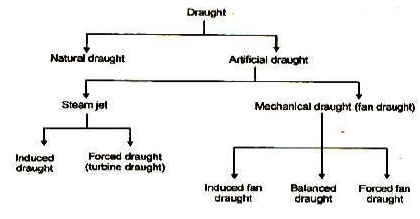
Artificial Draught
If the
draught is produced by steam jet or fan it is known as artificial draught
Steam jet Draught:
It
employs steam to produce the draught
Mechanical draught
It
employs fan or blowers to produce the draught.
Induced draught
The flue
is drawn (sucked) through the system by a fan or steam jet
Forced draught
The air
is forced into system by a blower or steam jet.
Natural Draught:
Natural draught system employs a
tall chimney as shown in figure. The chimney is a vertical tubular masonry
structure or reinforced concrete. It is constructed for enclosing a column of
exhaust gases to produce the draught. It discharges the gases high enough to
prevent air pollution. The draught is produced by this tall chimney due to
temperature difference of hot gases in the chimney and cold external air
outside the chimney.
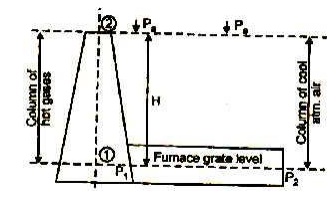
Artificial Draught
It has been seen that the draught
produced by chimney is affected by the atmospheric conditions. It has no
flexibility, poor efficiency and tall chimney is required. In most of the
modern power plants, the draught used must be independence of atmospheric
condition, and it must have greater flexibility (control) to take the
fluctuating loads on the plant.
Today’srgelasteam
power plants requiring 20 thousand tons of steam per hour would be impossible
to run without the aid of draft fans. A chimney of an reasonable height would
be incapable of developing enough draft to remove the tremendous volume of air
and gases (400 × 10 3 m3 to 800 × 103 m3 per
minutes). The further advantage of fans is to reduce the height of the chimney
needed.
The draught required in actual
power plant is sufficiently high (300 mm of water) and to meet high draught
requirements, some other system must be used, known as artificial draught. The
artificial draught is produced by a fan and it is known as fan (mechanical)
draught. Mechanical draught is preferred for central power stations.
Forced Draught
In a forced draught system, a
blower is installed near the base of the boiler and air is forced to pass
through the furnace, flues, economizer, air-preheater and to the stack.
This draught system is known as
positive draught system or forced draught system because the pressure and air
is forced to flow through the system.
The arrangement of the system is
shown in figure. A stack or chimney is also in this system as shown in figure
but its function is to discharge gases high in the atmosphere to prevent the
contamination. It is not much significant for producing draught therefore
height of the chimney may not be very much
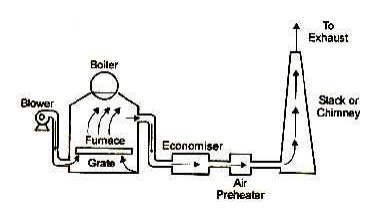
Induced
Draught:
In this system, the blower is
located near the base of the chimney instead of near the grate. The air is
sucked in the system by reducing the pressure through the system below
atmosphere. The induced draught fan sucks the burned gases from the furnace and
the pressure inside the furnace is reduced below atmosphere and induces the
atmospheric air to flow through the furnace. The action of the induced draught
is similar to the action of the chimney. The draught produced is independent of
the temperature of the hot gases therefore the gases may be discharged as cold
as possible after recovering as much heat as possible in air-preheater and
economizer.
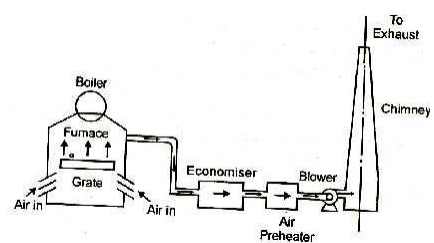
Balanced
Draught:
It is always preferable to use a combination of
forced draught and induced draught instead of forced or induced draught alone.
If the forced draught is used alone, then the furnace cannot be opened either
for firing or inspection because the high pressure air inside the furnace will
try to blow out suddenly and there is every chance of blowing out the fire
completely and furnace stops.
If the induced draught is used
alone, then also furnace cannot be opened either for firing or inspection
because the cold air will try to rush into the furnace as the pressure inside
the furnace is below atmospheric pressure. This reduces the effective draught
and dilutes the combustion.
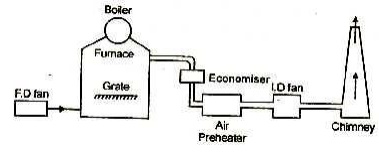
Related Topics